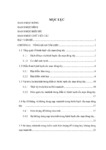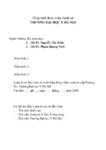
Please use this identifier to cite or link to this item:
http://dulieuso.hmu.edu.vn/handle/hmu/1967| Title: | Đánh giá hiệu quả của Nilotinib trên người bệnh bạch cầu mạn dòng tủy giai đoạn mạn đề kháng hoặc không dung nạp với Imatinib |
| Authors: | Phù Chí, Dũng |
| Advisor: | GS.TS. Nguyễn Tấn, Bỉnh GS.TS. Phạm Quang, Vinh |
| Keywords: | 62720151;Huyết học và truyền máu |
| Abstract: | Những đóng góp mới của luận án:. Đặc điểm lâm sàng và sinh học của các người bệnh kháng hay không dung nạp imatinib.. Đa số người bệnh có đặc điểm lâm sàng và chỉ số huyết học bình thường. Có 32,1% người bệnh có đột biến kháng imatinib (phổ biến nhất là đột biến E355A/G, E453V/K/Q và đột biến chèn đoạn). Đánh giá đáp ứng và thời gian sống còn sau điều trị nilotinib. Tỷ lệ người bệnh đạt đáp ứng huyết học hoàn toàn (CHR) cộng dồn tại thời điểm sau 6 tháng điều trị nilotinib là 97,6%. Tỷ lệ đạt đáp ứng di truyền tế bào hoàn toàn (CcyR) và đáp ứng sinh học phân tử phần lớn (MMR) 24 tháng lần lượt là 66,7% và 51,9%. Tỷ lệ sống toàn bộ (OS) và tỷ lệ sống không tiến triển bệnh (PFS) sau 2 năm điều trị nilotinib lần lượt là 97,9% và 93,1%.. Độc tính liên quan đến nilotinib trong nghiên cứu:. Giảm tiểu cầu là độc tính liên quan huyết học phổ biến nhất. Kéo dài đoạn QTc, tăng đường huyết, tăng cholesterol và tăng enzym gan là những độc tính không liên quan huyết học phổ biến nhất trong nghiên cứu. Có 5/112 người bệnh ngưng điều trị do độc tính của thuốc.. Clinical and biological characteristics of chronic myeloid leukemia patients who are resistant to or intolerant of imatinib. Most of patients had clinical and biological characteristics in normal range. BCR-ABL kinase domain mutations were detected in 32.1% of patients (E355A/G, E453V/K/Q and insertions were dominant mutations).. Evaluation of response and survival after second-line nilotinib treatment. The 6-month cummulative incidence of complete hematologic response (CHR) was 97.6%. The 2-year cummulative incidences of complete cytogenetic response (CCyR) and major molecular response (MMR) were 66.7% and 51.9%, respectively. The 2 – year cummnlative incidences of overall survial (OS) and progression – free survival were 97,9% and 93,1%, respectively.. Adverse effects of nilotinib:. Thrombocytopenia was the most common hematologic adverse effects. The most frequent nonhematologic toxicities were QT prolongation, hyperglycemia, hypercholesterolemia and elevated liver enzymes. There were 5/112 patients who had to discontinue nilotinib due to severe toxicities.. |
| URI: | http://dulieuso.hmu.edu.vn//handle/hmu/1967 |
| Appears in Collections: | Luận án (nghiên cứu sinh) |
Files in This Item:
| File | Description | Size | Format | |
|---|---|---|---|---|
| 486_TVLA PHUCHIDUNG.pdf Restricted Access | 3.63 MB | Adobe PDF |  Sign in to read | |
| 486_TTLA PhuChiDung.pdf Restricted Access | 972.39 kB | Adobe PDF |  Sign in to read |
Items in DSpace are protected by copyright, with all rights reserved, unless otherwise indicated.